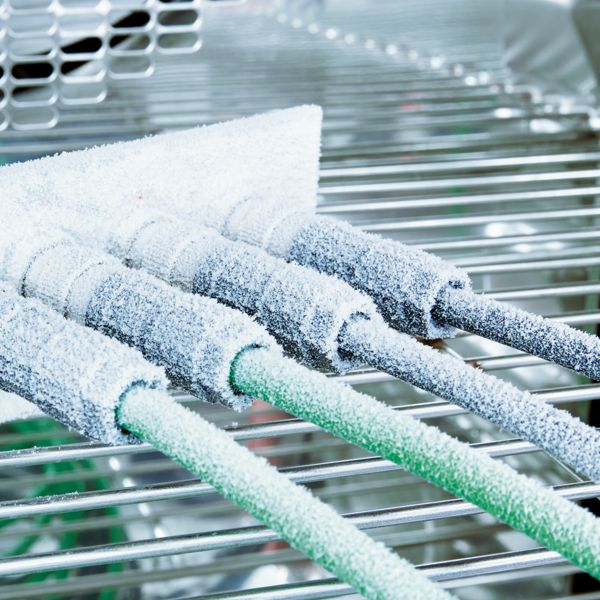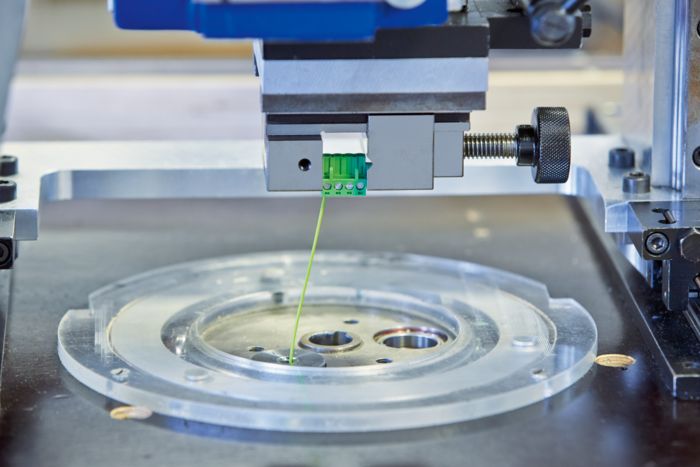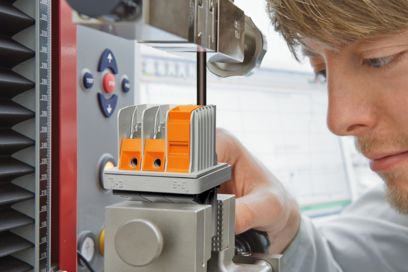Mechanical tests for connectors and electronics housings High quality through optimum resistance under external physical influences in test batch B: PCB terminal blocks, connectors, or electronics housings are tested to determine factors such as the strength and the deformation, bending, and fracture behavior of the housing, conductor outputs, and contact surfaces.

As the second milestone, test batch B includes the following laboratory tests:
- Flexion test and bending test (IEC 60999-1)
- Conductor connection capacity
- Conductor pull-out test (IEC 60998-2-1)
- Drop test
- Impact test (UL 746C)
- Cold impact test in accordance with UL 746C, 57/UL 1703, 30
- Flammability and fire resistance test (UL 30, UL 57, UL 1703)
- Conductor connection capacity
- Lock-in position of electrical contacts
- Insertion and withdrawal force
- Number of plugging cycles
- Multiple wiring
- Touch-proof protection (IEC 60529)
- Polarization and coding
- Micro-sections

Flexion test on a connector
Flexion test or rotation test in accordance with IEC 60999‑1
Correctly wired terminals must offer a high degree of mechanical safety. This includes reliable connection of the conductor. Therefore, tests are performed using solid and stranded connecting cables with the smallest cross-section, with the rated cross-section, and with the maximum cross-section.
A vertically fixed male connector is connected to a conductor. A test weight corresponding to the cross-section is attached at the end of the conductor. The conductor is fed through a central 37.5 mm aperture in a rotating disc and turned on its own axis 135 times. Afterwards, the contact must pass a conductor pull-out test in accordance with the IEC 60998-2-1 standard. Terminal points from Phoenix Contact are designed to ensure that the conductor makes contact in the clamping area gently. This prevents damage to the conductor and contact point which still have the same properties even after multiple wiring.

Conductor pull-out test being performed on a connector
Conductor pull-out test in accordance with IEC 60998‑2‑1
Tensile forces can affect the terminal point when being handled or during wiring or operation. To test the tensile load capacity, the terminal point must withstand a given tensile force based on the cross-section for 60 seconds. This test is performed after the flexion test and thus represents a stricter requirement. The tensile force exerts stress on the conductor at the terminal point. The conductor must be held without damage. The test results for connections from Phoenix Contact exceed the required minimum values by up to 150%.

Cold impact test being performed on a SUNCLIX connector
Cold impact test in accordance with UL 746C, 57/UL 1703, 30
Cable-connected connectors and housings can be subject to impacts. These can occur due to tools that have been dropped, for example, or objects that become airborne in a storm. The corresponding stresses are simulated by letting a test weight fall on the test object with a defined impact energy. In the process, the air clearances and creepage distances to the live elements on the test object can be shortened due to deformations or fractures. This is checked after the test is performed using a test probe or by testing the high-voltage and insulation properties. Due to the less favorable mechanical properties at low temperatures, the test is performed after storing the test objects at -35°C.

Touch protection test on a connector in an electronics housing
Protection against contact in accordance with IEC 60529
Electrical devices, systems, or installations must also provide a high level of safety to service technicians during service or maintenance. Therefore, connecting material must be built with a protection against electrical shock so that during professional installation, live parts are not accessible. Protection against contact is checked using one test probe or test ball that is placed on each opening of the connecting material with a defined force.








